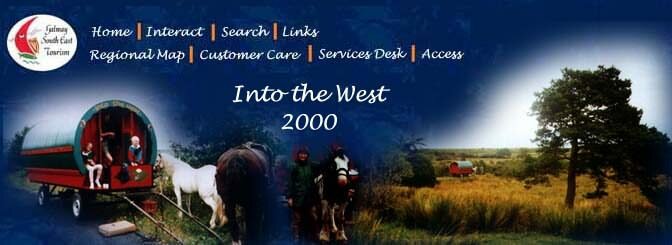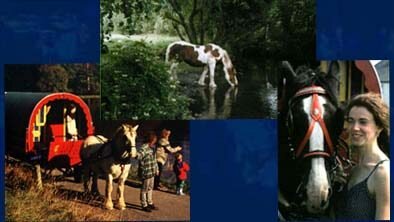|
|
The Horse & Harness
In the course of an enjoyable and happy horse drawn caravan holiday, you will inevitably develop a special relationship with your horse. Your horse has been tested for his temperament, health, road behavior, driving skills and many other qualities, before being entrusted to you. Like people, horses have personalities (horsealities ?) Some visitors are more active, some taller and some more confident than others. This is taken into account by the operator when choosing a horse but the horse has plenty of experience of people.
The breed used can vary but it is generally Irish Draught, with a strong influence of Traveller Horse and some lesser of Shire and Clydesdale,
Fine traditional skills are embodied in the hand crafted, well oiled and cared for harness worn by the caravan horse. Either 'common' or 'van' harness is used to attach the horse to the caravan. In bye gone days the 'common' harness was used by farmers and cart-men, the 'van' harness by delivery van-men.
As part of the preparation before leaving the operator's base, you will be instructed and given practice in watering, feeding and caring for the health of the horse as well as in harnessing and unharnessing, yoking and unyoking.
Riding horses are often available for rent. You may hire one to travel with the caravan, or to explore beaches, open country roads and mountainsides, when the caravan is parked.
Visitors travel between 7 km and 20 kms per day. This takes between two and five hours, depending on the speed of the horse.
Preparing the Harness - Practical Tips
1. Put on the winkers/bridle (the pieces with the bit). This can be put on over the halter which stays on
2. Put on the collar
3. Then fasten the hames (made of wood or metal) securely in the recess on the collar. Keep the long traces from trailing on the ground by crossing them over the horses back.
4. Put on the straddle/housen and the attached breeching (tail piece). Fasten the body strap (girth) just behind the forelegs. These are the shorter pair of straps.
5. Buckle one end of the reins to the bit on the near left side of the horse. Pass the other end through the rings on the hames and on the straddle/housen. Go to the other side of the horse and continue in the reverse order.
6. Reverse the horse into the shafts, lift them up and slip the tugs over the shaft arms. The tugs are the leader loops on the back band. Don't fasten the breaching straps yet.
7. The ends of the traces are now hooked to the caravan-end of the shafts.
8. The breeching strap loops the traces, goes through a ring on the shafts and fastens back onto itself.
9. Then you can buckle the back belly strap, leaving it slightly loose.
10. Now you're ready to go
11. When unharnessing follow these instructions in the reverse order.
Please note the above process is a lot more simple than it seems. It is fairly easy to master after instruction and a short practice session of 10 to 20 minutes.
Further Useful Information
Please click the links below to review detailed additional information - hints and tips on handling horses, the routes and designated stopping points and facilities etc
Contact Information
Props:
Larry and Patricia Gohery
-
- Postal address:
-
Cartron House Farm, Ballinakill, Kylebrack, Loughrea, Co Galway, Ireland Tel Outside Ireland: +353 509 45211. Internally at 0509 45211. Fax: +353 509 45987 Int 0509 45987
- Email Address:
Further enquiries or booking intention:
-
Email to




 Doras Award - 4 Shamrocks
Doras Award - 4 Shamrocks